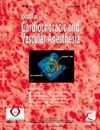体外循环前临界闭合压预测体外循环后急性肾损伤。
IF 2.3
4区 医学
Q2 ANESTHESIOLOGY
Journal of cardiothoracic and vascular anesthesia
Pub Date : 2025-02-01
DOI:10.1053/j.jvca.2024.11.010
引用次数: 0
摘要
目的:体外循环(CPB)期间的最佳血压目标仍然不确定,需要新的指标来个性化灌注目标。临界闭合压(Pcrit)是与血管张力相关的动脉循环的基本特性,代表了影响整个体循环流量的流出压力。我们研究了Pcrit作为急性肾损伤(AKI)的预后标志物。设计:回顾性队列研究。背景:单一三级医院研究对象:我们纳入了1038例接受CPB的成人心脏手术患者。干预措施:使用CPB开始前的动脉波形数据计算Pcrit。根据标准肾脏疾病改善全球结局定义,检查Pcrit与2期或更高期术后AKI发生率的关系。测量和主要结果:在纳入研究的1038例患者中,50例(5%)经历AKI。AKI患者术前危险因素较高,重度慢性肾脏疾病发生率较高,胸外科学会危险评分较高(p < 0.01)。手术次数和交叉钳夹次数均较长(p < 0.01)。所有患者在CPB期间保持相似的平均动脉压。患有AKI的患者比未患有AKI的患者有明显更高的旁路预压(49.0 mmHg vs 44.1 mmHg;P = 0.018)。在多变量回归中,Pcrit仍然是一个重要的预测因子,预分流Pcrit每增加5 mmHg, AKI风险增加16% (p = 0.011)。结论:较高的预分流prcrit与较高的术后AKI发生率相关。未来的研究有必要探讨在CPB期间使用术中Pcrit来确定个性化的血压目标。本文章由计算机程序翻译,如有差异,请以英文原文为准。
Prebypass Critical Closing Pressure Predicts Acute Kidney Injury After Cardiopulmonary Bypass
Objectives
Optimal blood pressure goals during cardiopulmonary bypass (CPB) remain uncertain and new metrics to individualize perfusion targets are needed. Critical closing pressure (Pcrit) is a fundamental property of the arterial circulation related to vascular tone and represents the outflow pressure impacting flow across the systemic circulation. We examined Pcrit as a prognostic marker of acute kidney injury (AKI).
Design
Retrospective cohort study.
Setting
Single tertiary care hospital
Participants
We included 1,038 adult cardiac surgery patients who underwent CPB.
Interventions
Pcrit was calculated using arterial waveform data before initiation of CPB. Pcrit was examined in relation to incidence of stage 2 or higher postoperative AKI according to standard Kidney Disease Improving Global Outcomes definitions.
Measurements and Main Results
Of the 1,038 patients included in the study, 50 (5%) experienced AKI. Patients who suffered AKI had significantly higher preoperative risk factors, including higher incidence of severe chronic kidney disease and higher Society of Thoracic Surgeons risk score (p < 0.01). They also had longer operative times and longer cross-clamp times (p < 0.01). All patients were maintained at similar mean arterial pressure while on CPB. Patients who suffered AKI had a significantly higher prebypass Pcrit than those who did not (49.0 mmHg vs 44.1 mmHg; p = 0.018). In a multivariate regression, Pcrit remained a significant predictor, representing a 16% increased risk of AKI for each 5 mmHg increase in prebypass Pcrit (p = 0.011).
Conclusions
A higher prebypass Pcrit is associated with a significantly higher incidence of postoperative AKI. Future study is warranted to investigate using intraoperative Pcrit to determine a personalized blood pressure goal during CPB.
求助全文
通过发布文献求助,成功后即可免费获取论文全文。
去求助
来源期刊
CiteScore
4.80
自引率
17.90%
发文量
606
审稿时长
37 days
期刊介绍:
The Journal of Cardiothoracic and Vascular Anesthesia is primarily aimed at anesthesiologists who deal with patients undergoing cardiac, thoracic or vascular surgical procedures. JCVA features a multidisciplinary approach, with contributions from cardiac, vascular and thoracic surgeons, cardiologists, and other related specialists. Emphasis is placed on rapid publication of clinically relevant material.

 求助内容:
求助内容: 应助结果提醒方式:
应助结果提醒方式:


